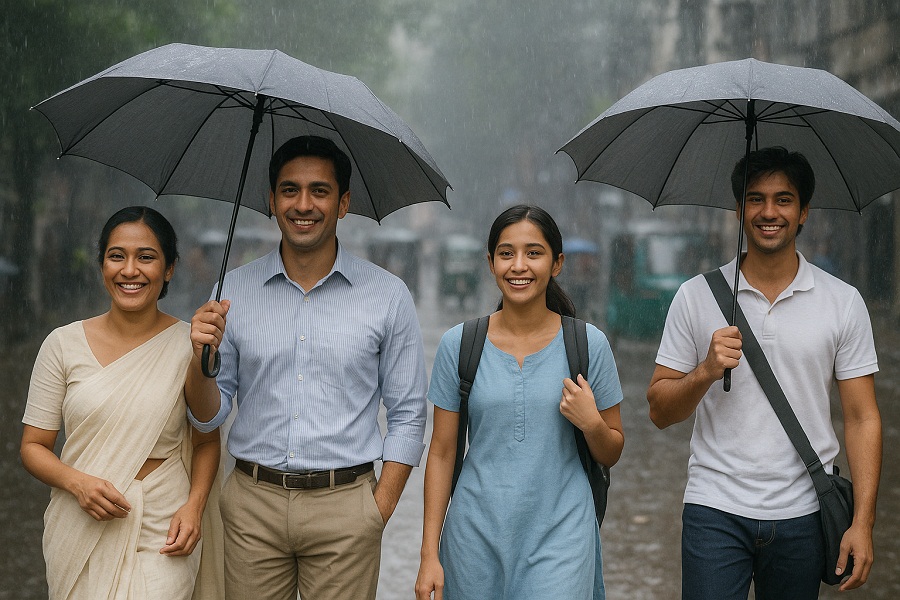
Published :
Updated :

Dhaka in the monsoon is a city of contradictions. The air is thick with the smell of wet earth, yet the streets are sticky with traffic fumes. The sky can go from a dull silver to a menacing charcoal in minutes, and when the clouds finally burst, they do so with no warning.
The rains bring relief from the scorching summer heat. Still, they also bring their own set of daily battles, damp clothes, humidity, and the constant risk of looking like you've just stepped out of a sauna.
For those of us who still want to look put-together, whether we're rushing to the office or hurrying across a university campus, monsoon fashion isn't just about style; it's about survival.
Humidity makes fabrics cling to the skin, heat makes the sweat flow, and the city's pollution clings to you as if it has nowhere else to go.
This is where the fabric you choose becomes your best ally.
In the monsoon, cotton is not just a fabric; it's a lifeline. Linen runs a close second, and viscose isn't bad either if you want something softer.
They all breathe, they all dry faster, and they don't make you feel like you're wearing a plastic bag in Dhaka's damp heat.
For office-goers, the challenge is dressing formally enough for work while still feeling human in this weather. Men can't go wrong with light cotton shirts — the kind that hold their shape without sticking to your back by the time you reach your desk.
Lighter colours look fresher and reflect the sun on those days when the clouds suddenly clear. Pairing them with quick-dry trousers means you're not spending the afternoon with damp hems after wading through a flooded street.
For women, a soft muslin or light khadi saree can be a godsend. These fabrics don't get heavy when wet, they dry relatively quickly, and they drape in a way that still looks elegant even after a sprint from the rickshaw stand to the office door. Prints or small patterns are clever here as they hide water spots and creases better than solid colours.
For those who wear burkas, the monsoon can be especially challenging. Heavy fabrics trap heat, while dark colours show every drop of rain. Switching to lighter cotton or rayon makes a huge difference, as does choosing a looser cut that allows the air to flow.
A front-open style layered over breathable clothing underneath can be surprisingly comfortable. If you're loyal to black, go for a lighter weave and avoid thick embroidery. It might look beautiful. Still, it will feel like armour in Dhaka's humidity.
Students have a little more room to experiment, though university campuses in the rain can be messy. So ankle-length trousers, palazzos, or salwar suits in quick-dry cotton blends are ideal.
A kurti in breathable fabric paired with light trousers works well for long days moving between classrooms.
Jeans, as reliable as they are in cooler months, become a nuisance in the monsoon as they're heavy when wet and take forever to dry.
For young men, polo shirts, casual button-downs, or even a well-fitting T-shirt in light cotton paired with chinos or joggers can keep things simple and comfortable.
Footwear also matters here. Nothing ruins a day like soggy canvas shoes. Rubber sandals or loafers that can handle puddles are far better companions.
Sarees in the monsoon deserve their mention. This is the season for handloom cotton, jamdani, and airy muslin.
They're elegant without being high-maintenance, and they dry much faster than silk or synthetic blends.
Bright colours like coral, mustard, and deep teal pop beautifully against the season's grey skies and even lift your mood on dreary mornings.
White sarees might look stunning, but unless you have the skill of walking through Dhaka's streets without a single splash, they're risky.
Accessories need to work as hard as your clothes in the monsoon. Leather bags are best left at home. Nothing ages them faster than rainwater.
Waterproof totes or synthetic crossbody bags are far more forgiving.
A cheerful, compact umbrella can double as a fashion statement, and a light scarf or stole can serve as an extra shield from the rain while adding texture to your look.
Colours in this season aren't just about mood, they're about practicality. Dark shades like navy or charcoal hide stains well, but they also absorb more heat.
Pastels and mid-tones, mint, lavender, dusty rose are cooler on sunny days and still forgiving when the rain starts to fall.
Pairing a printed blouse with a plain saree or mixing a patterned kurti with neutral bottoms is an easy way to bring variety without complicating your laundry.
The city's pollution adds another wrinkle to the monsoon wardrobe. Rainwater here isn't the fresh, clean kind you see in postcards; it carries dust and grime from the streets. This makes delicate fabrics harder to maintain.
Raw silk, organza, and other fine weaves can easily stain, while cotton blends and viscose hold up better against frequent washing. A quick rinse after a rainy commute is often the difference between saving and losing an outfit.
A light shrug or open-front tunic can protect your clothes during the commute and be taken off when indoors. It's also handy for those moments when the rain brings a sudden chill to the air.
Monsoon in Dhaka is all about fabrics that breathe, colours that forgive. It cuts that let you move easily when you're dodging puddles.
The rains in Dhaka have a way of slowing the city down without stopping it. Rickshaws will be stuck in traffic, tea stalls will be filled with conversation, and people will be seen standing under a shop's shade. They will find ways to look effortlessly themselves, even with wet hems and windblown hair. That's the charm of monsoon fashion here.
asif.khan@gmail.com


 For all latest news, follow The Financial Express Google News channel.
For all latest news, follow The Financial Express Google News channel.